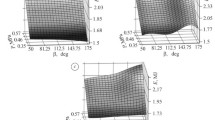Experimental studies have been made on the formation of highly active cavitation zones in fluid media at high pressures (up to 6.5 MPa) and temperatures (up to 150°C) with the use of a high-power ultrasonic installation. It has been shown that attempts to increase the cavitation intensity in single-component and multicomponent media by increasing the power of the ultrasonic installation to above a certain limit lead to a strong degradation of the cavitation processes. This is due to the appearance of hydrodynamical flows generated by longitudinal vibrations of the installation radiator waveguide. Eliminating or weakening such flows makes it possible to increase markedly the efficiency of cavitation treatment by increasing the medium pressure (in the range of 0.5–1.5 MPa) and choosing the optimum ratio between the temperature of the medium and the power of the ultrasonic installation (specific acoustic power of the radiator). We recommend to use for the cavitation intensity index the acoustic activity of the cavitation zone (acoustic noise amplitude in the frequency range of 200 kHz–10 MHz), as well as its physical activity determined by the destruction rate of thin-layer indicators.
Similar content being viewed by others
References
A. K. Kurochkin, G. F. Davydov, et al., Intensification of some processes of raw material processing by means of acoustic vibrations, Khim. Tekhnol. Pererab. Nefti Gaza, No. 10, 15–17 (1982).
A. S. Besov, K. Yu. Koltunov, S. O. Bulev, V. N. Kirilenko, S. I. Kuz′menkov, and E. I. Pal′chikov, Destruction of hydrocarbons in the cavitation region in the presence of an electric field by aqueous solutions of electrolytes, Pis′ma Zh. Tekh. Fiz., 29, Issue 5, 71–76 (2003).
I. E. Él′piner, Ultrasound: Physicochemical and Biological Action [in Russian], Fizmatgiz, Moscow (1963).
M. A. Margulis, Principles of Sonic Chemistry [in Russian], Vysshaya Shkola, Moscow (1984).
A. K. Kurochkin and E. A. Smorodov, Experimental investigation of the cavitation in hydrodynamic rotor radiators, Akust. Zh., XXXIII, Issue 4, 707–711 (1987).
B. I. Bakhtin, A. V. Desyatov, A. P. Kubyshkin, and A. S. Skorokhodov, Features of cavitation and cavitation erosion of waveguides of powerful ultrasonic units at higher-than-average pressure of the media, J. Eng. Phys. Thermophys., 81, No. 4, 717–723 (2008).
B. I. Bakhtin, A. V. Desyatov, O. I. Korba, A. P. Kubyshkin, and A. S. Skorokhodov, Low-temperature cracking of hydrocarbons in cavitation ultrasonic fields, Mir Nefteprodukt. Vestn. Neft. Komp., No. 6, 14–18; Nos. 7–8, 52–58 (2009).
B. I. Bakhtin, A. I. Ivashov, A. V. Kuznetsov, and A. S. Skorokhodov, Experimental investigation of the specific features of the formation of cavitation zones in intense ultrasound fields, J. Eng. Phys. Thermophys., 87, No. 3, 672–685 (2014).
Ya. B. Zel′dovich and Yu. P. Raizer, Physics of Shock Waves and High-Temperature Hydrodynamic Phenomena [in Russian], Nauka, Moscow (1966).
A. V. Desyatov, D. N. Il′mov, and S. G. Cherkasov, Mathematical simulation of the evolution of a single spherical vapor bubble compressed by external pressure, Teplofiz. Vys. Temp., 46, No. 1, 92–99 (2008).
V. G. Kozlov, Experimental Investigation of the Averaged Vibrational Dynamics of Incompressible Liquid, Doctoral Dissertation (in Physics and Mathematics), Permsk. Gos. Pedagog. Univ., Perm′ (1997).
S. I. Kas′kov, B. I. Bakhtin, A. V. Desyatov, and A. P. Kubyshkin, A Method of Combined Processing of Oil-Containing Raw Materials and a Device for the Purpose, RF Patent No. 2408656, Byul. No. 1 (2011).
Author information
Authors and Affiliations
Corresponding author
Additional information
Translated from Inzhenerno-Fizicheskii Zhurnal, Vol. 89, No. 3, pp. 662–669, May–June, 2016.
Rights and permissions
About this article
Cite this article
Bakhtin, B.I., Ivashov, A.I., Kuznetsov, A.V. et al. Formation of Zones with Maximum Supersonic Cavitation Intensity in Single-Component and Multicomponent Media. J Eng Phys Thermophy 89, 671–677 (2016). https://doi.org/10.1007/s10891-016-1425-5
Received:
Published:
Issue Date:
DOI: https://doi.org/10.1007/s10891-016-1425-5




